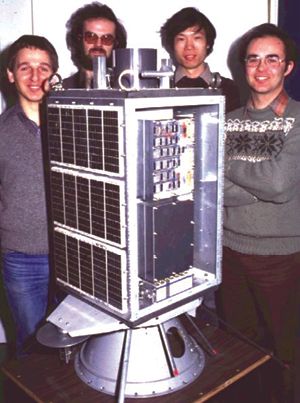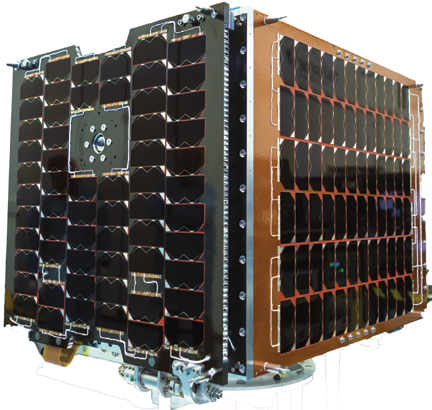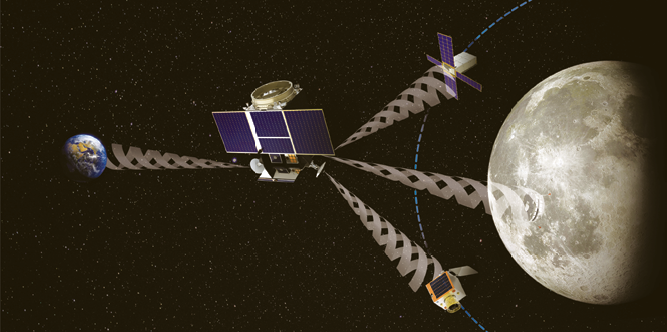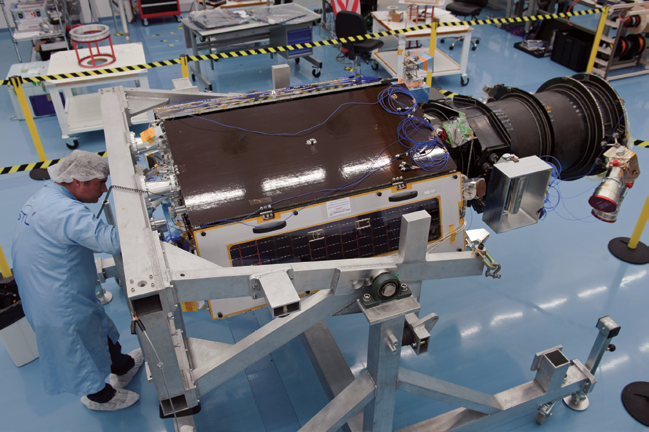The very first satellites were physically small and lightweight not by design but due to the constraints of the launchers available at
the time.

As launcher capability developed, the mass of satellites rapidly grew and the ‘Space Race’ of the 1960s saw ever larger and more sophisticated spacecraft in orbit around the Earth and beyond. There was no thought of a “small” satellite or otherwise — there were simply satellites, and they were being developed to operate in an environment that was not yet well understood.
However, as more knowledge was gained of the space environment and technology moved on at a rapid pace, so the options for operating in space were broadened and the possibilities for satellites, large or small, broadened with them. Nowadays, rather than defining small satellites by just their physical parameters, the phrase small satellite (smallsat) can also refer to the approach taken toward building the satellites.
The hallmark of the modern smallsat is the adoption of up-to-date consumer technologies combined with rapid development cycles. These are executed by small agile teams operating closer to IT industry management models rather than those traditionally found in military/aerospace organizations.
One of the first modern smallsats, and arguably the first reprogrammable one, was UoSAT-1, launched in 1981 (see photo to the left). Built by a group of radio amateurs and researchers at the University of Surrey (Guildford, UK), this smallsat successfully demonstrated that it was possible to compile software on the ground and upload it to a satellite that was designed and built using Commercial Off-The-Shelf (COTS) components.
These researchers epitomized what is now commonly considered as the characteristics of a smallsat team: highly innovative technical staff operating as part of a small motivated unit, working in close proximity and with effective communications.
Despite this “enlightened” way of working, it took a long time for smallsats to catch on — during the 1980s, they were largely considered to be of interest, but of little real use.
However, as COTS technologies steadily advanced over the next 10 to 20 years, interest grew in their use for technology demonstration, rudimentary Earth Observation (EO), radio science, military applications and, in particular, training programs for developing space nations. By the early 2000s, micro-/mini-satellites were capable of meeting operational and commercial needs and the smallsat revolution had begun.
Fast-forward to the present day and that small group of researchers has become Surrey Satellite Technology Limited, a successful global company founded by Sir Martin Sweeting whose original vision for SSTL was to enable “Affordable access to Space” and then to “Change the Economics of Space” — SSTL’s first straplines.
With a pioneering spirit and an ethos of innovation, SSTL was pretty much alone when the company set out to achieve this goal some 35 years ago. Now, with the emergence of many so-called NewSpace companies founded on the premise of using small, low cost satellites, it is clear that SSTL has, indeed, been instrumental in fundamentally changing the economics of space.
Today SSTL continues to push the boundaries of what is possible with smallsats from both a technological perspective as well as with business models and processes and is specializing in a few, key areas. SSTL is committed to “Doing Space Differently” — the new company strapline. The aim is not to grow to become another major space prime, but rather to retain the agility that comes with a small company to focus on trialling new technologies and to share that knowledge with society as a whole.
The Smallsat Market and the NewSpace Drivers for Change
Today’s smallsat market is undergoing some major changes. Smallsats have enabled the economic production of large constellations and there are now many companies that are planning, or who have already launched, the first spacecraft of their megaconstellations, primarily to provide communication services from Low Earth Orbit (LEO).

As the world waits to see what effect these constellations will have on the telecoms business, so, too, do the traditional customers for large geostationary telecoms satellites — the number of orders for these traditional satellites have dramatically dropped during the last couple of years.
As the industry fully embraces the smallsat approach, NewSpace companies and others are realizing there are new applications that can now be achieved at a price point that enables a business case to be closed. Many of these companies need to purchase their equipment or satellite platforms from the incumbent providers, while others are adopting the benefits of vertical integration and in-house production and building the satellites themselves.
Commercial EO is still in its infancy (at least, in comparison to the more established business of telecoms), and it seems unlikely that the EO market will grow fast enough for all the new players to be successful. With the exception of China, and possibly a few other countries, government budgets the world over are tight.
The commercial telecoms business is holding its breath. Commercial EO business is booming, but could be somewhat overstretched.
Traditional institutional business, lagging slightly in their acceptance of the benefits of the smallsat way, do not always have access to timely budget allocations to allow them to keep up, technologically speaking.
There are clearly challenges ahead for the global space industry; however, this is also an exciting time for the industry. Never before have so many companies been trying to do so many different things in space. Coupled now with private launcher enterprises, such as SpaceX, Rocket Labs and Blue Origin, and the recent government and private announcements to return to the Moon (and beyond), this could make the next decade as interesting as the Apollo-era 50 years ago.

EO: Chasing the Holy Grail of Persistent Surveillance Everywhere
Optical instruments have long been the schedule drivers for satellite missions, with precision optical systems taking a long time to build and align. A decade ago, having long been successful in using COTS components to build satellite platforms, SSTL turned its attention toward applying the same principles to spacecraft optics.
It is well established that it is not possible to take just any commercial parts and then fly them in space. The challenge is in working out which components can be successfully used and then applying the appropriate level of testing, something that SSTL has now been doing for more than 30 years.
An interesting challenge presented itself: was it possible to take a mass-produced off-the-shelf telescope, readily available at a low-price, and fly it in space? Using internal R&D funding SSTL set out to achieve just that, and, with an opportunistic, but looming launch deadline only seven months away and a blank sheet of paper, a small team set out to build Carbonite-1, a Video-from-space technology demonstrator flying a COTS telescope.

Photo of the 1 meter resolution DMC3 satellite imager. Image is courtesy of SSTL.
The satellite was built in six months and 12 days, a remarkable achievement that also included the design-from-scratch of a new tip off mechanism to allow the satellite to be housed and deployed from a new launch position on ISRO’s PSLV launcher.
The Carbonite-1 mission (image, above, left) was a great success and Carbonite-2 quickly followed, building on the lessons learned from the first mission, turning a proof-of-concept mission into one that was ready to be fully exploited.
This can-do approach, combining the core principles established by SSTL with an innovative approach to optical instruments, has now been met with widespread interest — three customers are now lined up to procure seven additional Carbonite-class spacecraft.
SSTL is now well into the process of applying these Carbonite principles to other areas of the electromagnetic spectrum, with thermal infra-red and synthetic aperture radar spacecraft in development, opening up new applications and markets.
The coming of the Age of the Constellation, combined with this new approach to building a different class of optical instruments, brings the industry one step closer to being able to achieve the Holy Grail of persistent surveillance everywhere (as opposed to anywhere), at a reasonable price.
There has long been talk of having a large Hubble-sized telescope in geostationary orbit, but pointing toward the ground. With only a single satellite, such could achieve persistent surveillance of anywhere (or at least one selected location at any time).

Image capture by CARBONITE-2 of the Dubai airport, UAE, and is courtesy of SSTL.
More of the same satellites in a geostationary orbit can provide a few more “anywheres” but will never be the economical way of covering everywhere. An LEO constellation of imaging satellites could replace the persistent surveillance GEO and also take it to the next level — persistent surveillance of everywhere.
The EO roadmap at SSTL aims to develop the building blocks, demonstrate the technologies and achieve the price points that will enable this new chapter in observing the Earth.
Lunar — Innovation Beyond Earth’s Orbit
Keeping true to its pioneering roots, SSTL is now looking beyond Earth orbit and bringing the smallsat approach to lunar orbit. Working in partnership with ESA and Goonhilly Earth Station (GES), the concept is to provide commercial communication and navigation services to assets on the surface of, or orbiting around, the Moon.
The idea is simple: deploy a constellation of a few satellites that will act as a data relay for lunar assets for scientific and telemetry data. Depending on the need, a store and forward approach, or real time availability, will give the system enough flexibility to mutualize and optimize the constellation capacity, while keeping enough time and bandwidth to support critical moments of the mission.
The communication service will be particularly crucial for polar and far-side missions that do not have direct line of sight of the Earth and, therefore, require a data relay in order to communicate with ground stations.
Rather than designing and launching a dedicated data relay, customers for the service will be able to use the infrastructure in place and only pay for the usage they need.
The data relay will also support scientific lunar missions and provide the freedom for lunar rovers to wander Beyond Line of Sight (BLOS) of their lander, increase the longevity for missions to be able to survive the lunar night while dependent on the lander communication system, and offering simplicity for scientific missions to focus on designing the scientific mission and outsource the communication module.
Alongside the communication service, the plan is to take advantage of SSTL’s experience in building the European Galileo payloads by also providing a lunar navigation service that will assist orbital and surface lunar assets in achieving their missions.
Experience has recently shown once again that one of the most critical moments of a lunar mission is the approach and landing on the surface — accurate positioning in this phase can avoid unnecessary maneuvers as well as ensure that the landing site is the one selected by the mission, which can be the difference between success and failure.
It can also ensure better value of the scientific mission, as the precision of the landing site is not negligible when looking for specific resource in the regolith.
The aim is to integrate communications and navigation into a single service and, ultimately, by designing the need for ranging out of the lunar asset — this becomes an economical option for those wishing to visit the Moon on restricted budgets.
Thirty Years of Firsts
SSTL has a unique ethos of agility, audacious creativity and innovation, with a deep-rooted passion for promoting the use of space by everyone. These ethics have allowed SSTL to achieve more than 30 years of “Firsts” in the sector — a trajectory that continues and will keep pushing the smallsat revolution to achieve higher performance and new applications.
Additionally, there are many SSTL “Firsts” to list — early examples include the first civilian digital store-and-forward telecoms payload (UoSAT-2) and the first use of a GPS signal on a microsatellite for on-board orbit determination (PoSat).
Demonstrating an ethos of sharing know-how with the rest of the world, SSTL also built the first national satellites for South Korea, Portugal, Chile, Algeria, Thailand, Malaysia and Nigeria. SSTL also has the dubious honor of being one half of the first recorded and verified unintentional space debris impact by two man-made objects in Earth orbit when the CERISE satellite was hit by a discarded piece of a launch vehicle! Remarkably, thanks to the ingenuity of the engineers at SSTL and in spite of the decapitation of the gravity-gradient boom, the satellite was returned to service.
More recently, the launch of the SSTL-built LEO Vantage Phase 1 demonstrator spacecraft for Telesat has enabled the first ever test of 5G communication on a LEO spacecraft, and the RemoveDEBRIS spacecraft carried out the first in-orbit demonstration of space debris capture using four technologies including a net and a harpoon.
SSTL has also innovated in the approach to satellite ownership and leasing of imaging capacity, signing fractionated data deals for the DMC3 Constellation, the NovaSAR-1 S-Band radar mission and the high resolution optical imaging satellite, SSTL S1-4.

As SSTL continues to “Do Space Differently” a new revolution in smallsat missions looks set to get underway, encompassing LEO telecoms megaconstellations, new remote-sensing instrumentation and exploration beyond Earth’s orbit. These are exciting times for the space industry —and continuous innovation will be key to success.
www.sstl.co.uk
Andrew Cawthorne is the Director of Business Development and Sales for Surrey Satellite Technology Ltd. (SSTL).



